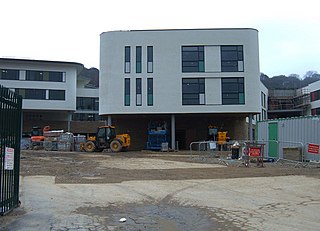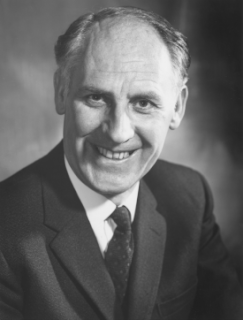This article needs additional citations for verification .(October 2018) |
Kenneth Alwyne Pounds, CBE, FRS (born 17 November 1934) is Emeritus Professor of physics at the University of Leicester.
This article needs additional citations for verification .(October 2018) |
Kenneth Alwyne Pounds, CBE, FRS (born 17 November 1934) is Emeritus Professor of physics at the University of Leicester.
He was born in Bradford, Yorkshire, where he went to Salt Grammar School (now Titus Salt School in Baildon). He then attended University College London where he gained his BSc and in 1961 a PhD under the supervision of Harrie Massey and Robert Lewis Fullarton Boyd.
He then moved to the University of Leicester as Assistant Lecturer in 1960. He became Deputy Director of Space Research in 1967, and was one of the pioneers of using rockets and satellites for research in the UK. He became first Director of the X-ray Astronomy group in 1974. His research is in the area of active galaxies, and one of his many discoveries is that black holes are common in the universe.
Ken Pounds became Professor of Space Physics in 1973. He was appointed Head of the Department of Physics in 1986, and the following year took the decision to merge with the Astronomy department to create the present Department of Physics and Astronomy.
He was a member of the Science and Engineering Research Council, 1980–1984; President of the Royal Astronomical Society, 1990–1992; and was seconded as the first Chief Executive of the newly formed Particle Physics and Astronomy Research Council, 1994–1998, following the restructuring of the Research Councils. He then returned to Leicester as Head of Department until his retirement in 2002. He remains active in the Department as a research fellow.
Pounds was elected a Fellow of the Royal Society in 1981, and appointed a CBE in 1984. He holds five honorary doctorates, including the rare distinction of an honorary degree from his own institution, the University of Leicester, in 2005. The asteroid 4281 Pounds, discovered by Edward Bowell in 1985, was named in his honour. The official naming citation was published by the Minor Planet Center on 4 October 1990 ( M.P.C. 17030). [1] In 2010, the National Portrait Gallery, London purchased a portrait of Pounds by the photographer Max Alexander for its permanent collection. [2]

The Cavendish Laboratory is the Department of Physics at the University of Cambridge, and is part of the School of Physical Sciences. The laboratory was opened in 1874 on the New Museums Site as a laboratory for experimental physics and is named after the British chemist and physicist Henry Cavendish. The laboratory has had a huge influence on research in the disciplines of physics and biology.

Antony Hewish was a British radio astronomer who won the Nobel Prize for Physics in 1974 for his role in the discovery of pulsars. He was also awarded the Eddington Medal of the Royal Astronomical Society in 1969.

Sir Peter Mansfield was an English physicist who was awarded the 2003 Nobel Prize in Physiology or Medicine, shared with Paul Lauterbur, for discoveries concerning Magnetic Resonance Imaging (MRI). Mansfield was a professor at the University of Nottingham.

Peter Ware Higgs is a British theoretical physicist, Emeritus Professor in the University of Edinburgh, and Nobel Prize laureate for his work on the mass of subatomic particles.

The University of Leicester is a public research university based in Leicester, England. The main campus is south of the city centre, adjacent to Victoria Park. The university's predecessor, University College, Leicester, gained university status in 1957.

Joseph Hooton Taylor Jr. is an American astrophysicist and Nobel Prize laureate in Physics for his discovery with Russell Alan Hulse of a "new type of pulsar, a discovery that has opened up new possibilities for the study of gravitation."

Michel Gustave Édouard Mayor is a Swiss astrophysicist and professor emeritus at the University of Geneva's Department of Astronomy. He formally retired in 2007, but remains active as a researcher at the Observatory of Geneva. He is co-laureate of the 2019 Nobel Prize in Physics along with Jim Peebles and Didier Queloz, and the winner of the 2010 Viktor Ambartsumian International Prize and the 2015 Kyoto Prize.

David Clifford Jewitt is a British-American astronomer who studies the Solar System, especially its minor bodies. He is based at the University of California, Los Angeles, where he is a Member of the Institute for Geophysics and Planetary Physics, the Director of the Institute for Planets and Exoplanets, Professor of Astronomy in the Department of Physics and Astronomy and Professor of Astronomy in the Department of Earth, Planetary and Space Sciences. He is best known for being the first person to discover a body beyond Pluto and Charon in the Kuiper belt.
Cyril Hilsum is a British physicist and academic.
George Ernest Kalmus, CBE, FRS is a noted British particle physicist.
Sir Robert Lewis Fullarton Boyd was a pioneer of British space science and founding director of the Mullard Space Science Laboratory.

Charles Wayne Rees CBE FRS FRSC was a British organic chemist.

Sir Peter Leonard Knight is a British physicist, professor of quantum optics and senior research investigator at Imperial College London, and principal of the Kavli Royal Society International Centre. He is a leading academic in the field of quantum optics and is the recipient of several major awards including the Royal Medal from the Royal Society and the Thomas Young Medal and Prize from the Institute of Physics. He is a former president of the Institute of Physics and the Optical Society of America, the first non North American-based person to take the position.
Scott Duncan Tremaine is a Canadian-born astrophysicist. He is a fellow of the Royal Society of London, the Royal Society of Canada and the National Academy of Sciences. Tremaine is widely regarded as one of the world's leading astrophysicists for his contributions to the theory of solar system and galactic dynamics. Tremaine is the namesake of asteroid 3806 Tremaine. He is credited with coining the name "Kuiper belt".

Titus Salt School formerly called Salt Grammar School located in Baildon, West Yorkshire, England is a former grammar school, now a mixed comprehensive school, for students aged 11–18. It is a specialist school in Mathematics and Computing. The Headteacher is Ian Morrel, who took up the role in September 2012.

William James Stirling was a physicist who served as the first Provost of Imperial College London. He was appointed to this role in August 2013 and retired in August 2018.

Raymond Hide CBE FRS was a British physicist, who was a professor of physics at the University of Oxford and, since 2000, senior research investigator at Imperial College, London.
Sir John Ivan George Cadogan was a British organic chemist.

Thomas K. Henning is a German astrophysicist. Since 2001, he is a director at the Max Planck Institute for Astronomy. Henning is an expert in the field of star and planet formation.
Shashikumar Madhusudan Chitre FNA, FASc, FNASc, FRAS was an Indian mathematician and astrophysicist, known for his research in Astronomy and Astrophysics. The Government of India honored him, in 2012, with Padma Bhushan, the third highest civilian award, for his services to the sciences.